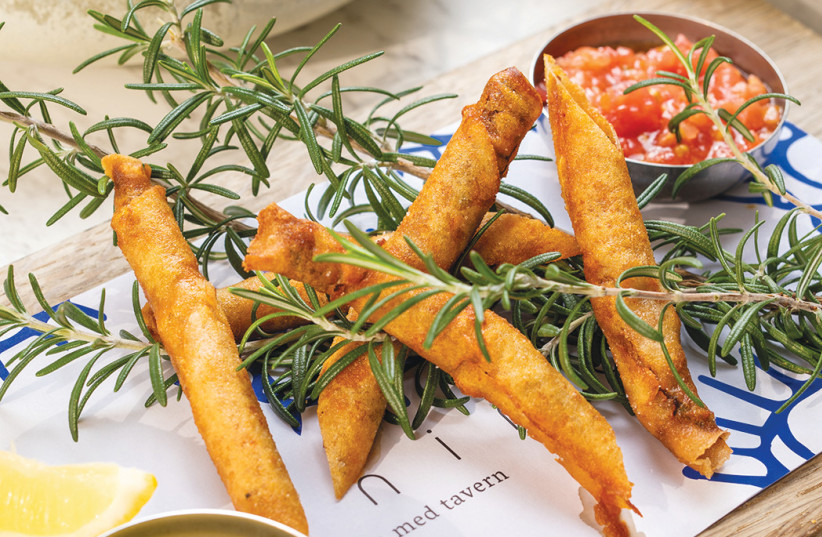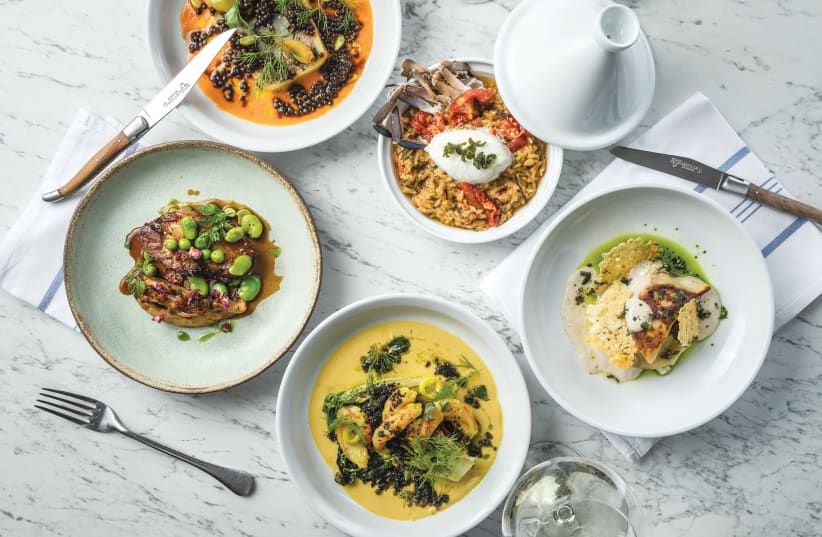Hillel Tavakoli may just be the best Israeli chef that has yet to achieve celebrity status. After training abroad at a 3 Stars Michelin restaurant, he returned to Israel and made a name for himself locally at Pastel, the prestigious restaurant at the Tel Aviv Museum of Art. In 2019, he left to open a new concept of his own – a modern Mediterranean bistro and tavern with the exuberant name Animar.
Animar came to life in the premises inhabited in a former life by the legendary Rafael, and subsequently (briefly) by Victor Gloger’s Hola. In its current incarnation, the stunningly handsome decor is enhanced by an expansive view of the city’s beach promenade, extending endlessly to the sea beyond. Not to mention the lively yet unobtrusive eclectic international playlist spanning the Mediterranean basin, from North Africa to Turkey and the Balkans.
Fittingly, the music is a reflection of the many Mediterranean influences infusing Animar’s kitchen. The talented Tavakoli has created a distinctive menu that draws both on the classic cuisines of Spain, France and Italy, as well as on his own Libyan-Persian heritage.
Interestingly, many of the same influences may be found in Animar’s five specialty cocktails (NIS 49–59), from the vodka-infused “Spicy Daisy” with a Turkish spice blend to the rum-based “Animar Verde” with its bouquet of Persian herbs.
The extensive wine list helpfully begins with full pages of whites and reds classified by flavor characteristics, and continues to itemize bottles of vintages by country. The selection narrows considerably when it comes to availability by the glass (NIS 44–72), but the knowledgeable English-speaking wait staff will gladly help you find something you like.

The bilingual, seasonal food menu comprises five sections: Tiny Plates (NIS 14–26), Small Plates (NIS 58–82), Medium Plates (NIS 60–110), Large Plates (NIS 124–147) and Huge Plates (NIS 250-450). In addition, your waiter will explain the evening’s specials, which come in most categories. Vegetarian and gluten-free options are conveniently identified by symbols.
There is one house bread [basket] (NIS 26) consisting of large squares of fluffy whole wheat and white focaccia with an oniony crust, together with homemade seeded grissini (breadsticks). We enjoyed them both on their own and with the accompanying dips of olive oil, tomato salsa and tiny Syrian olives in harissa oil – but especially as needed to complement the tapas-sized dishes that were to follow during the course of the meal.
Officially, the Hebrew word for tiny plates is translated on the restaurant’s English menu as Starters, but they are more like saucers of appetizers, ideal for munching while sipping a cocktail. We did not try all of them, but our favorites were the confit of Egyptian fava beans (Ful Medames), the cloves of pickled garlic and the almonds in mild chili oil.
After puzzling over the detailed menu for a longer than usual time and grilling our patient waiter about the exact nature of dishes’ flavor profiles, we decided to focus on the smaller and intermediate plates, in order to taste a greater variety of different things, and postponed sharing a larger dish or two for a subsequent visit. As it was, our dilemma was partially resolved by the limited number of dishes in the last two categories and the fact that one of the two huge dishes was not available at all that evening.
The menu primarily features fish and seafood; in fact, there is no poultry at all (or ham for that matter, despite the abundance of shellfish). Meat is basically limited to beef and lamb, with the latter dominating.
As we prepared to give our order, our waiter gave us an unsolicited tip: It is not necessarily advisable to start with the small plates before proceeding to the medium-sized ones. For example, the raw fish dishes make the best entrées, regardless of which size category the plate falls in.
Accordingly, we began with the two crudo fish dishes, both of red tuna, since that was the freshest catch of the day. The “Spicy Wild Fish” was tartare and stunningly presented on two oyster shells – which disappeared all too quickly – while the four-serving red tuna sashimi was perched atop slices of Granny Smith apple and dressed with a savory curry vinaigrette, with crunchy caramelized cashews to round out the terrific interplay of flavors and textures.
Switching to cooked dishes, we sampled one warm small plate and one medium one. The former was the “Persian Lamb Cigars,” which was five small golden-brown cigarillos stuffed with a pungent mixture of ground lamb and piquant merguez sausage. The filling packed a punch to such an extent that it somewhat overwhelmed the accompanying dips of tangy amba aioli and mild tomato salsa.
Our sole seafood dish was “Squid,” a generous mound of calamari rings that belied its definition as an intermediate-sized dish. The calamari, gently fried in a thin coating of chickpea-rice flour breading, were piled high on a purple cabbage choucroute and enhanced by an outstanding beetroot-orange vinaigrette. From our first bite, we knew this was destined to be one of the most unforgettable seafood dishes we may ever eat.
There were other intriguing dishes that tempted us, but if we were going to taste Tavakoli’s unique desserts – which also bear the hallmarks of his exotic spice combinations – the time had come. The separate bilingual Sweets menu consists of two sections: five desserts (NIS 48-86) and four after-dinner drinks, two digestifs and two cocktails (NIS 25-62).
Thus, we ordered one dessert from each section. Our choice among the latter was easy: The “Espresso Martini Vodka”, with Creme de Cacao and cardamom. A few sips was all it took to realize that this was the best alcoholic dessert cocktail we had encountered in recent memory.
Interestingly, the first section, as in the main menu, had a giant-sized dessert in addition to the individually sized ones. Since we knew we could not possibly finish the “Family Rice Pudding,” after much deliberation we settled on the “Panna Cotta Spuma and Quince”, consisting of panna cotta foam with saffron vanilla ice cream, spiced pistachio crumble, and quince in saffron syrup. Once the ice cream melted a bit into the fluffy cream custard, the dessert was transformed into the ultimate light and sweet finish to a memorable meal.
The writer was a guest of the restaurant.
Animar (Not kosher). 87 Hayarkon St., Tel Aviv. Tel. (03) 575-9060.
